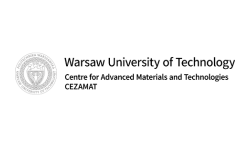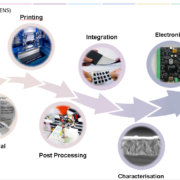Sustainable sensor Laboratory
About
In this laboratory we provide service of material manufacturing as well as necessary characterisation of the materials for sustainable sensors fabrication. We also provide equipment for various printing technologies with screen printing, aerosol jet printing and InkJet among others. Finally, we support the characterisation of the printed layers.
Description
The Department of Printed Electronics, Textronics and Assembly builds on the long-standing experience of the research staff in developing advanced materials for application by various printing techniques such as screen printing, ink jet printing, spray coating, aerosol jet, flexography and rotogravure. The research also focuses on the fabrication of electronic structures such as luminescent displays, textronic materials and graphene electrodes on flexible and stretchable substrates such as polymer film, common fabrics and paper. The laboratory has a complete line for the production of these materials comprising sonifiers, evaporators, planetary mills, triple-rollers, analytical scales, rheometers, viscometers, dryers, UV dryers, microscopes, ovens, profilometers, a chamber for climate and thermal shock tests.
Developments in the field of sustainable, green and eco-electronics require a base of both scientific expertise and appropriate infrastructure. Our department’s team includes experienced researchers with a successful background in a variety of technologies, including printed electronics applications in medicine and biomedical engineering, which are one of the biggest drivers behind the need for mild materials that are non-toxic, often water-soluble or even biocompatible. Awareness of the negative environmental impact of standard electronics materials and solutions also implies the need for change and research towards sustainable and green electronics.
The laboratory is divided into several zones, allowing for a wide spectrum of research. It has a zone for chemical processing, equipped with a series of fume hoods, homogenisers of various types and other equipment allowing the manufacture of modern materials using a number of techniques. In the section dedicated to the production of layers and paths, the laboratory features high-end printing equipment of various technologies: Screen Printing, AJP, InkJet, and Flexography. In the measuring section, we are able to measure, amongst other things, material rheology and adhesion, electrical parameters, printability and path thickness on an ongoing basis.
Technical specifications:
– max. heating temperatures in large area ovens up to 300°C, 1300°C for small area prints,
– printing area no larger than 30×40 cm (screen printing), 30×30 cm (aerosol-jet), 6×6 cm (inkjet).
Case study:
Case Study 1: Integration of Textronic Materials in Wearable Electronics
A researcher specializing in wearable electronics collaborated with the Department of Printed Electronics, Textronics, and Assembly to integrate advanced textronic materials into wearable device prototypes. The project focused on developing flexible and stretchable electronic circuits using graphene electrodes and advanced printing techniques such as inkjet and aerosol jet printing on fabrics and polymer films. This collaboration resulted in wearable electronics that were more comfortable and capable of accurately monitoring physiological signals, advancing the field and offering new insights into medical and biomedical applications.
Case Study 2: Creation of Biocompatible Sensors for Medical Diagnostics
In this case study, a research team focused on the development of biocompatible sensors for non-invasive medical diagnostics. Utilizing the laboratory’s expertise in printed electronics and the availability of advanced materials like water-soluble and biocompatible polymers, the team worked on fabricating sensors that could be applied directly to the skin or integrated into medical wearables. These sensors aimed to monitor vital signs or biochemical markers with minimal discomfort to the patient. The project leveraged technologies like screen printing and inkjet printing on flexible substrates, enabling the production of sensors that were not only accurate but also comfortable for long-term wear, thus paving the way for advancements in continuous health monitoring and personalized medicine.
Optional:
[1] Krzemiński, J.; Baraniecki, D.; Dominiczak, J.; Wojciechowska, I.; Raczyński, T.; Janczak, D.; Jakubowska, M. Hybrid Printing of Silver-Based Inks for Application in Flexible Printed Sensors. Crystals 2023, 13, 720. https://doi.org/10.3390/cryst13050720.
[2] Raczyński, T.; Janczak, D.; Szałapak, J.; Lepak-Kuc, S.; Baraniecki, D.; Muszyńska, M.; Kądziela, A.; Wójkowska, K.; Krzemiński, J.; Jakubowska, M. Influence of the Heat Transfer Process on the Electrical and Mechanical Properties of Flexible Silver Conductors on Textiles. Polymers 2023, 15, 2892. https://doi.org/10.3390/polym15132892.
[3] Pepłowski, A.; Budny, F.; Jarczewska, M.; Lepak-Kuc, S.; Dybowska-Sarapuk, Ł.; Baraniecki, D.; Walter, P.; Malinowska, E.; Jakubowska, M. Self-Assembling Graphene Layers for Electrochemical Sensors Printed in a Single Screen-Printing Process. Sensors 2022, 22, 8836. https://doi.org/10.3390/s22228836.
Access Provider / Facilities








